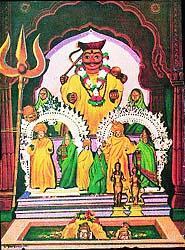|
Page < 1 2 3 4 5 6 7 8 9 10 11 12 13 14 >
Degeneration of the Varna
System
The Varna system was started as analogous
to professional guilds, but as a result of exploitation by some priests, and
socio-economic elements of society, this system became hereditary and
degenerated over the centuries. The ancient culture of India was
based upon a system of social diversification according to spiritual
development.
 Four orders of society were recognized based upon the four main goals of human
beings and established society accordingly. These four groups were the Brahmins,
the priests or spiritual class; the Kshatriya, the nobility or ruling class; the
Vaishya, the merchants and farmers; and the Shudras or servants.
These four orders of society were called "varna", which has
two meanings; first it means "color" and second it means a
"veil". As color it does not refer to the color of the skin
of people, but to the qualities or energies of human nature.
As a veil it shows
the four different ways in which the Divine Self is hidden in human beings.
Four orders of society were recognized based upon the four main goals of human
beings and established society accordingly. These four groups were the Brahmins,
the priests or spiritual class; the Kshatriya, the nobility or ruling class; the
Vaishya, the merchants and farmers; and the Shudras or servants.
These four orders of society were called "varna", which has
two meanings; first it means "color" and second it means a
"veil". As color it does not refer to the color of the skin
of people, but to the qualities or energies of human nature.
As a veil it shows
the four different ways in which the Divine Self is hidden in human beings.
In ancient India, these divisions were not based on birth but based on
qualifications. According to the Bhagavad Gita this Aryan family system broke
down in India over three thousand years ago at the time of Krishna. Hence after
three thousand years this system of determining natural aptitude has degenerated
into the caste system which resembles it now only in form.
As the Varna system became increasingly rigid and
based on inheritance, it was enveloped by another system known as the caste
system. Thus, this varna system determined the social
structure of ancient Hindu society. The caste system could not have been part of
Hindu religious philosophy, since it violates fundamental Hindu doctrine,
according to which there is no absolute distinction between individuals, since
the atman dwells in the hearts of all beings. There is no religious sanction
whatsoever to the concept of the caste system in Hinduism.
Swami Sivananda (The Divine Life Society,
Rishikesh), in his commentary on Gita,Ch.18, verses 41,and 45 says:
"Mankind is organized into the four castes and each man's life is divided
into four stages, according to the nature of the Gunas (traits) and the degree of growth
or evolution. This is the division of labor for which each caste is fitted
according to its own nature. The duty prescribed is your sole support, each
devoted to his own duty in accordance with his own nature or caste, and
the highest service you can render to the Supreme is to carry it out
whole-heartedly, without expectation of fruits, with the attitude of dedication
to the Lord.
The caste system is, indeed, a splendid thing. It is quite flawless. But the
defect came in from somewhere else. The classes gradually neglected their
duties. The test of ability and character slowly vanished. Birth became the
chief consideration in determining castes. All castes fell from their ideals and
forgot all about their duties."
Varna - Not Racial Color
Varna
was conferred on the basis of the intrinsic nature of an individual, which is a
combination of the three gunas. The term, 'Varna', has nothing to do with racial color. It is related to the
three 'gunas' or traits - white (sattva or sagacity), red (rajas or
aggressiveness), and dark (tamas or ignorance) which all men and also all living
beings possess, albeit in different proportions- varying from species to
species, from man to man and even from sibling to sibling.
(source: The
Hindu Mind: Fundamentals of Hindu Religion and Philosophy for All Ages - By Bansi Pandit p 125-128).
Alain
Danielou has said: "That abusive caste practices were introduced
when the administrative power ceased to be in Hindu hands, thus making the
repression of abuses legally impossible. Such abuses as
there are have been greatly exaggerated in order to justify Western domination
and are normally quite local. In most of India, the caste system
functions today as it always has; as a harmonious whole in which each is
satisfied with his social lot, in which the freedom of each tribe, and religious
group to live according to its customs, traditions, and convictions is respected
as it is in no other country and no other form of society.
(source:
Virtue,
Success, Pleasure, & Liberation : The Four Aims of Life in the Tradition of
Ancient India - Alain Danielou
p. 45).
Watch
video - Brahmins
in
India
have become a minority
Page < 1 2 3 4 5 6 7 8 9 10 11 12 13 14 >
|